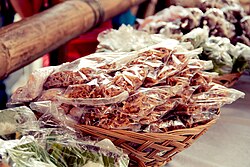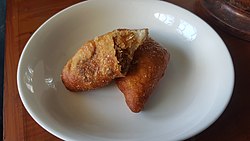   Top: Freshly-made bukayo; Center: Packaged bukayo in a market in Silay; Bottom: Bitsu-bitsu doughnut with bukayo filling | |
| Alternative names | Bucaio, bucayo, bokayo, bukayu, bukhayo, conserua de coco |
|---|---|
| Type | Dessert |
| Place of origin | Philippines |
| Main ingredients | Gelatinous coconut, water, sugar or brown sugar |
| Variations | Bocarillo |
Bukayo is a Filipino dessert made from sweetened coconut strips. It is traditionally made by simmering strips or shredded bits of young, gelatinous coconut (buko) in water and sinuklob, which is sugarcane muscovado melted into a chewy caramel-like consistency.[1][2][3][4] Dryer versions of bukayo with a crumbly texture are known as bocarillo.[4] Bukayo can be eaten on its own, usually rolled into little balls. But they can also be used as garnishing and fillings for other desserts, most notably for pan de coco, moche, and sinudlan empanada.[2][5]
Bukayo is also spelled as bucaio, bucayo, bokayo, bukhayo, or bukayu in other regions. During the Spanish rule of the Philippines, it was known as conserva de coco ("coconut preserve") in Spanish.[5][6] It is also known as hinti' in Tausug.[7]
Peanut brittle in the Philippines is also sometimes locally known as bukayo mani.[5]
- ^ "Bukayo Recipe". Pinoy Recipe at Iba Pa. November 28, 2014. Retrieved May 20, 2018.
- ^ a b "Bukayo". Ang Sarap. January 16, 2013. Retrieved May 20, 2018.
- ^ Jesse D. Dagoon, Aida L. Dagoon, & Jasmin Flora L. Dagoon (1997). Culinary Arts II: Specialized Course in Home Technology for the Fourth Year High School. Rex Bookstore, Inc. pp. 151–152. ISBN 9789712321573.
{{cite book}}: CS1 maint: multiple names: authors list (link) - ^ a b "Bukayo / Bocarillo". Fiipino-food-recipes.com. Retrieved May 20, 2018.
- ^ a b c Edgie Polistico (2017). Philippine Food, Cooking, & Dining Dictionary. Anvil Publishing, Incorporated. ISBN 9786214200870.[permanent dead link]
- ^ Jean-Paul G. Potet (2017). Ancient Beliefs and Customs of the Tagalogs. Lulu Press Inc. p. 235. ISBN 9780244348731.
- ^ Polistico, Edgie (December 28, 2012). "daral". Philippine Food Illustrated. Retrieved January 15, 2020.